The Sierra de Cacheuta Vein-Type Se Mineralization, Mendoza Province, Argentina
Abstract
:1. Introduction and Geological-Historical Background
2. Methods
- (a)
- Rolling grinding (loose abrasive grains). In this case, the surface is velvet. In dispersed-light dark field illumination, the internal structures (like foliation and fine folding) of the opaque metallic minerals are clearly visible.
- (b)
- Polishing (bonded abrasive grains). In this case, the surface is polished. In dispersed-light dark field illumination, the polished opaque metallic minerals appear black.
3. Results
3.1. Petrography of Trachytic Host Rock
3.2. The Cacheuta Vein-Type Se Mineralization
3.2.1. Mineralogy and Structural Features
3.2.2. Micro-Structural Features
- Deformation (d1): First vein opening and brecciation of the trachytic host rock.Stage (I) corresponds to the zonal and granular growth generation (g1) cementing host rock fragments.
- Deformation (d2): Compression and subsequent shearing of stage (I) selenides causing foliation and isoclinal folding.Stage (II) corresponds to the crystal-plastic flow, rotation, dissolution, replacement, and/or recrystallization of stage (I) selenides.
- Deformation (d3): Second vein opening, fragmentation of stage (I) and (II) selenidesStage (III) corresponds to the growth generation (g3) of Cu–Fe sulfides and the formation of major shrinking cracks in selected selenides.
- Deformation (d4): Fourth vein opening, fragmentation of stage (I)–(III) aggregates.Stage (IV) corresponds to the intensive alteration of pre-existing selenides and the formation of various alteration minerals, resulting in growth generation (g4), cementing all previous structures.
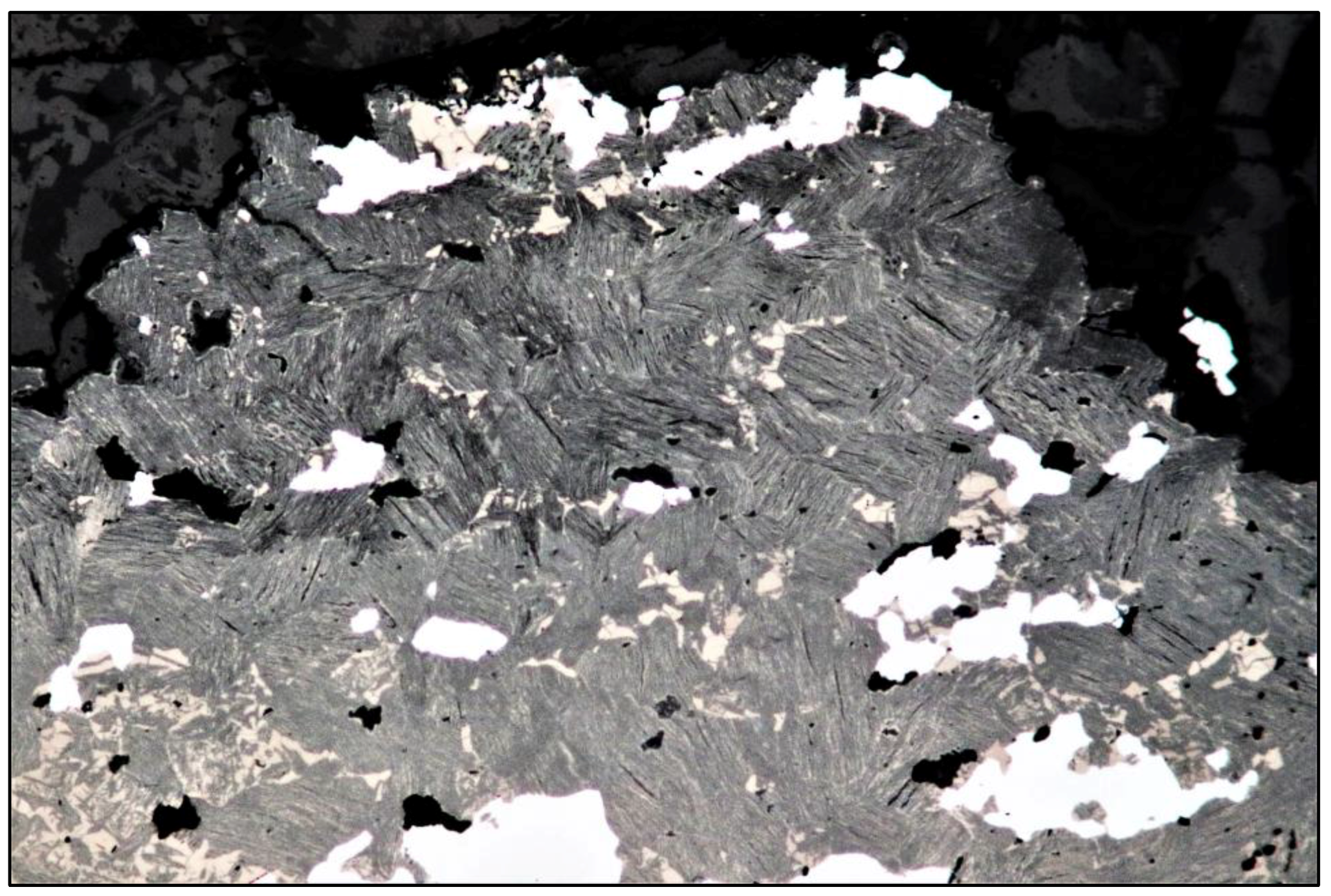
3.2.3. Mineral Chemistry
4. Discussion
4.1. Sources of Elements
4.2. Origin of Se Mineralization
4.3. Diagnostic Features of Cacheuta, Mendoza, Compared to the Se Deposits of the Province of La Rioja
- (1)
- Occurrence of trachytic host rock fragments containing ferroselite, bitumen, and TiO2 pseudomorphs after titanomagnetite.
- (2)
- Several thin zones of trogtalite in Co-rich krut’aite-(g1) (Co < 6.7 wt %) pseudomorphs, representing several stages of selenide deposition.
- (3)
- The selenides show striking evidence of dominant ductile flow, recrystallization, and strain accumulation exceeding that in the adjacent trachytic host rock that only suffered brittle deformation.
- (4)
- Early, Co-rich krut’aite (originally comprising up to 20 vol % of the selenides) is largely replaced by clausthalite, umangite, klockmannite, eskebornite, Ni-poor tyrrellite (Ni < 2.7 wt %) and trogtalite (Ni < 1.2 wt %), as well as krut’aite and petříčekite of end-member composition.
- (5)
- Calcite gangue, Hg–selenides (tiemannite), berzelianite, and native gold are lacking.
- (6)
- Formation of numerous Se-bearing alteration minerals, possibly including mandarinoite, mereheadite, orlandiite, and scotlandite.
- (7)
- Presence of an unnamed Cu selenide (ideal formula either Cu2Se3 or Cu5Se8).
Acknowledgments
Author Contributions
Conflicts of Interest
References
- Paar, W.H.; de Brodtkorb, M.K.; Putz, H.; Martin, R.F. Atlas of Ore Minerals: Focus on Epithermal Deposits of Argentina; Mineralogical Association of Canada: Québec, QC, Canada, 2016; Volume 11, p. 408. [Google Scholar]
- Paar, W.H.; Sureda, R.J.; de Brodtkorb, M.K. Mineralogía de los yaciminientos de selenio en La Rioja, Argentina. Krutaita, tyrrellita y trogtalita de Los Llantenes. Rev. Assoc. Geol. Argent. 1996, 51, 304–312. [Google Scholar]
- Paar, W.H.; Amann, G.; Topa, D.; Sureda, R.J. Gold and palladium in the Sierra de Umango and Los Llantenes selenide districts, La Rioja, Argentina. In Proceedings of the Memoria del XIV Congreso Geologico Boliviano, La Paz, Bolivia, 14–18 November 2000; pp. 465–469. [Google Scholar]
- Paar, W.H.; Topa, D.; Roberts, A.C.; Criddle, A.J.; Amann, G.; Sureda, R.J. The new mineral species brodtkorbite, Cu2HgSe2, and the associated selenide assemblage from Tuminico, Sierra de Cacho, La Rioja, Argentina. Can. Mineral. 2002, 40, 225–237. [Google Scholar] [CrossRef]
- Paar, W.H.; Topa, D.; Makovicky, E.; Sureda, R.J.; de Brodtkorb, M.H.; Nickel, E.H.; Putz, H. Jagüeite, Cu2Pd3Se4, a new mineral species from El Chire, La Rioja, Argentina. Can. Mineral. 2004, 42, 1745–1755. [Google Scholar] [CrossRef]
- De Brodtkorb, M.K.; Crosta, S. Sobre los yaciemientos de Se de la “Sierra de Umango”, provincia de la Rioja. Rev. Assoc. Geol. Argent. 2010, 67, 272–277. [Google Scholar]
- Bindi, L.; Förster, H.-J.; Grundmann, G.; Keutsch, F.N.; Stanley, C.J. Petříčekite, CuSe2, a new member of the marcasite group from the Předbořice deposit, Central Bohemia Region, Czech Republic. Minerals 2016, 6, 33. [Google Scholar] [CrossRef]
- Stelzner, A. Beiträge zur Geologie und Palaeontologie der argentinischen Republik: Geologischer Teil; Palaentographica; Suppl. 3; Theodor Fischer: Berlin, Germany, 1885. [Google Scholar]
- Stelzner, A. Mineralogische Beobachtungen im Gebiete der argentinischen Republik. Tschermak’s Min. Mitt. 1873, 219–254. [Google Scholar]
- Domeyko, I. Excursiones y Trabajos Entre 1840–1873; Geología San Félix veta Descubridora: Chañarcillo, Chile, 1873. [Google Scholar]
- Brackebusch, L. Die Bergwerksverhältnisse der argentinischen Republik. Zeitschrift Berg- Hütten- und Salinenwesen 1893, 41, 15–47. [Google Scholar]
- Ramdohr, P. Die Erzmineralien und ihre Verwachsungen; Akademie-Verlag: Berlin, Germany, 1975; p. 904. [Google Scholar]
- Armstrong, J.T. CITZAF: A package of correction programs for the quantitative electron microbeam X-ray-analysis of thick polished materials, thin films, and particles. Microbeam Anal. 1995, 4, 177–200. [Google Scholar]
- Dunn, P.J.; Peacor, D.R.; Sturman, B.D. Mandarinoite, a new ferric-iron selenite from Bolivia. Can. Mineral. 1978, 16, 605–609. [Google Scholar]
- Hawthorne, F.C. The crystal structure of mandarinoite, Fe3+2Se3O9·6H2O. Can. Mineral. 1984, 22, 475–480. [Google Scholar]
- Camprostrini, I.; Gramaccioli, C.M.; Demartin, F. Orlandiite, Pb3(SeO3)(Cl,OH)4·H2O, a new mineral species, and an associated lead-copper selenite chloride from the Baccu Locci mine, Sardinia, Italy. Can. Mineral. 1999, 37, 1493–1498. [Google Scholar]
- Krivivichev, S.V.; Turner, R.; Rumsey, M.; Siidra, O.O.; Kirk, C.A. The crystal structure and chemistry of mereheadite. Min. Mag. 2009, 73, 103–117. [Google Scholar] [CrossRef]
- Paar, W.H.; Braithwaite, R.S.W.; Chen, T.T.; Keller, P. A new mineral, scotlandite (PbSO3) from Leadhills, Scotland: The first naturally occurring sulfite. Min. Mag. 1984, 48, 283–288. [Google Scholar] [CrossRef]
- Grundmann, G.; Förster, H.-J. Origin of the El Dragón selenium mineralization, Quijarro province, Potosí, Bolivia. Minerals 2017, 7, 68. [Google Scholar] [CrossRef]
- Keutsch, F.N.; Förster, H.-J.; Stanley, C.J.; Rhede, D. The discreditation of hastite, the orthorhombic dimorph of CoSe2, and observations on trogtalite, cubic CoSe2, from the type locality. Can. Mineral. 2009, 47, 969–976. [Google Scholar] [CrossRef]
- Johan, Z.; Picot, P.; Kvačeck, M. La krut’aite, CuSe2, un nouveau minéral du groupe da la pyrite. Bull. Soc. Fr. Minéral. Cristallogr. 1972, 95, 475–481. [Google Scholar]
- Grundmann, G.; Lehrberger, G.; Schnorrer-Köhler, G. The El Dragόn mine, Potosí, Bolivia. Mineral. Rec. 1990, 21, 133–146. [Google Scholar]
- Bindi, L.; Cipriani, C.; Pratesi, G.; Trosti-Ferroni, R. The role of isomorphous substitutions in natural selenides belonging to the pyrite group. J. Alloys Compd. 2008, 459, 553–556. [Google Scholar] [CrossRef]
- Criddle, A.J.; Stanley, C.J. The Quantitative Data File for Ore Minerals, 2nd ed.; British Museum (Natural History): London, UK, 1986; pp. 274–275. [Google Scholar]
- Stanley, C.J.; Criddle, A.J.; Lloyd, D. Precious and base metal selenide mineralization at Hope’s Nose, Torquay, Devon. Mineral. Mag. 1990, 54, 485–493. [Google Scholar] [CrossRef]
- Diehl, S.F.; Goldhaber, M.B.; Koenig, A.E.; Lowers, H.A.; Ruppert, L.F. Distribution of arsenic, selenium, and other trace elements in high pyrite Appalachian coals; evidence for multiple episodes of pyrite formation. Int. J. Coal Geol. 2012, 94, 238–249. [Google Scholar] [CrossRef]
- Parnell, J.; Brolly, C.; Spinks, S.; Bowden, S. Selenium enrichment in Carboniferous shales, Britain and Ireland: Problem or opportunity for shale gas extraction. Appl. Geochem. 2016, 66, 82–87. [Google Scholar] [CrossRef] [Green Version]
- Yudovich, Y.E.; Ketris, M.P. Selenium in coal: A review. Int. J. Coal Geol. 2006, 67, 112–126. [Google Scholar] [CrossRef]
- Krivovichev, V.; Charykova, M.; Vishnevsky, A. The thermodynamics of Se minerals in near-surface environment. Minerals 2017, 7, 188. [Google Scholar] [CrossRef]
- Bullock, L.A.; Parnell, J.; Perez, M.; Feldmann, J.; Armstrong, J.G. Selenium and other trace element mobility in waste products and weathered sediments at Parysh Mountain copper mine, Anglesey, UK. Minerals 2017, 7, 229. [Google Scholar] [CrossRef]
- Coleman, L.; Bragg, L.J.; Finkelman, R.B. Distribution and mode of occurrence of selenium in US coals. Environ. Geochem. Health 1993, 15, 215–227. [Google Scholar] [CrossRef] [PubMed]
- Simon, G.; Kesler, S.E.; Essene, E.J. Phase relations among selenides, sulphides, tellurides, and oxides: II. Applications to selenide-bearing ore deposits. Econ. Geol. 1997, 92, 468–484. [Google Scholar] [CrossRef]

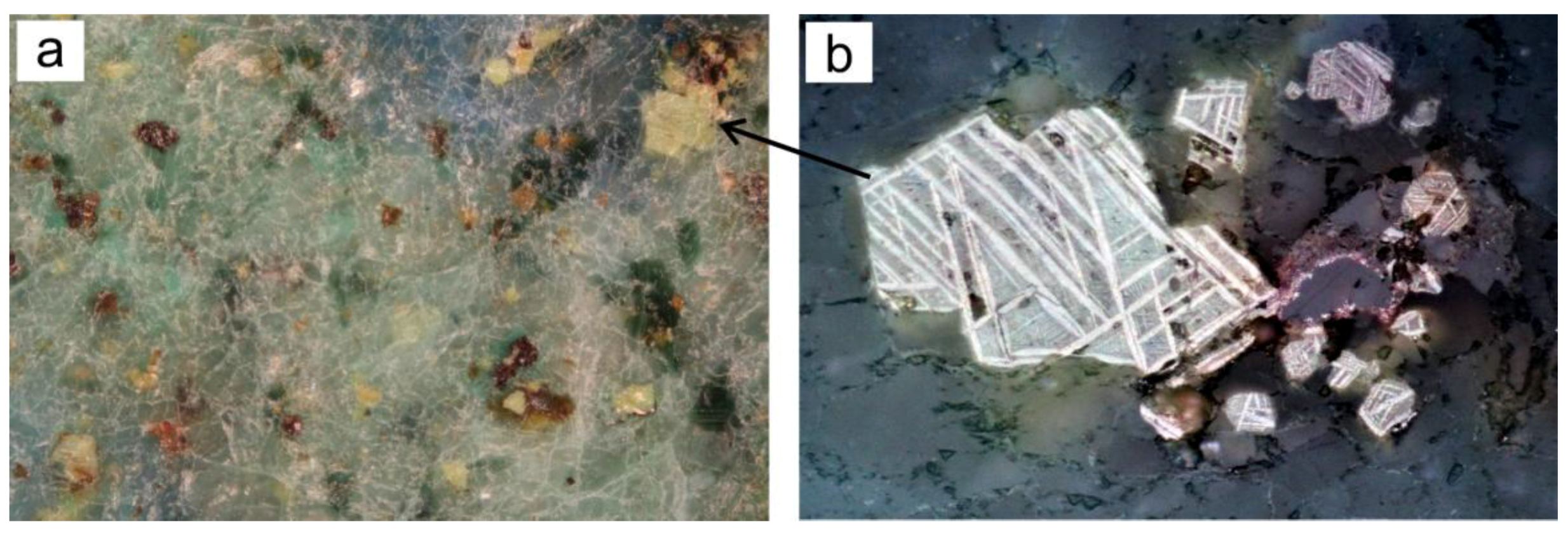
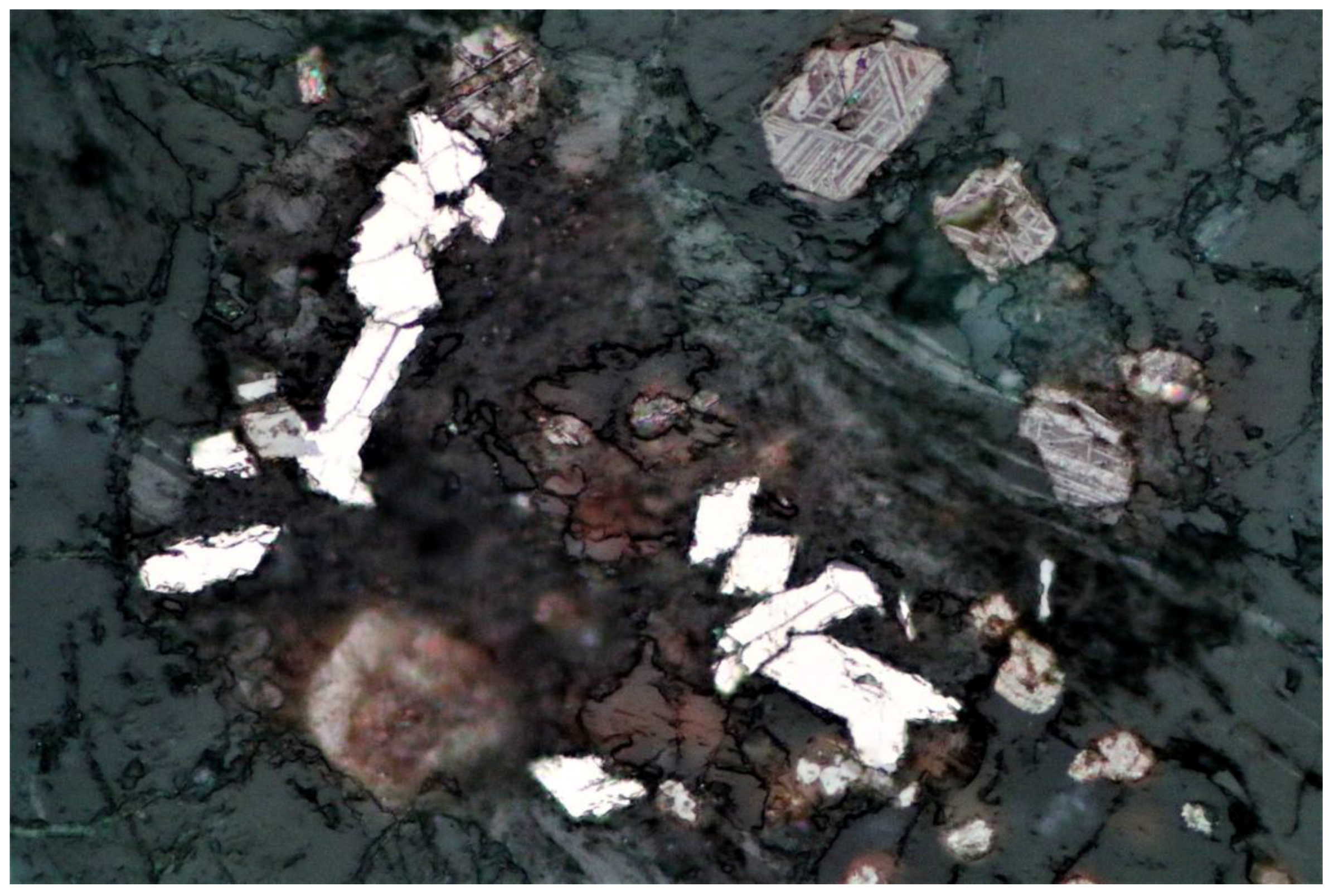
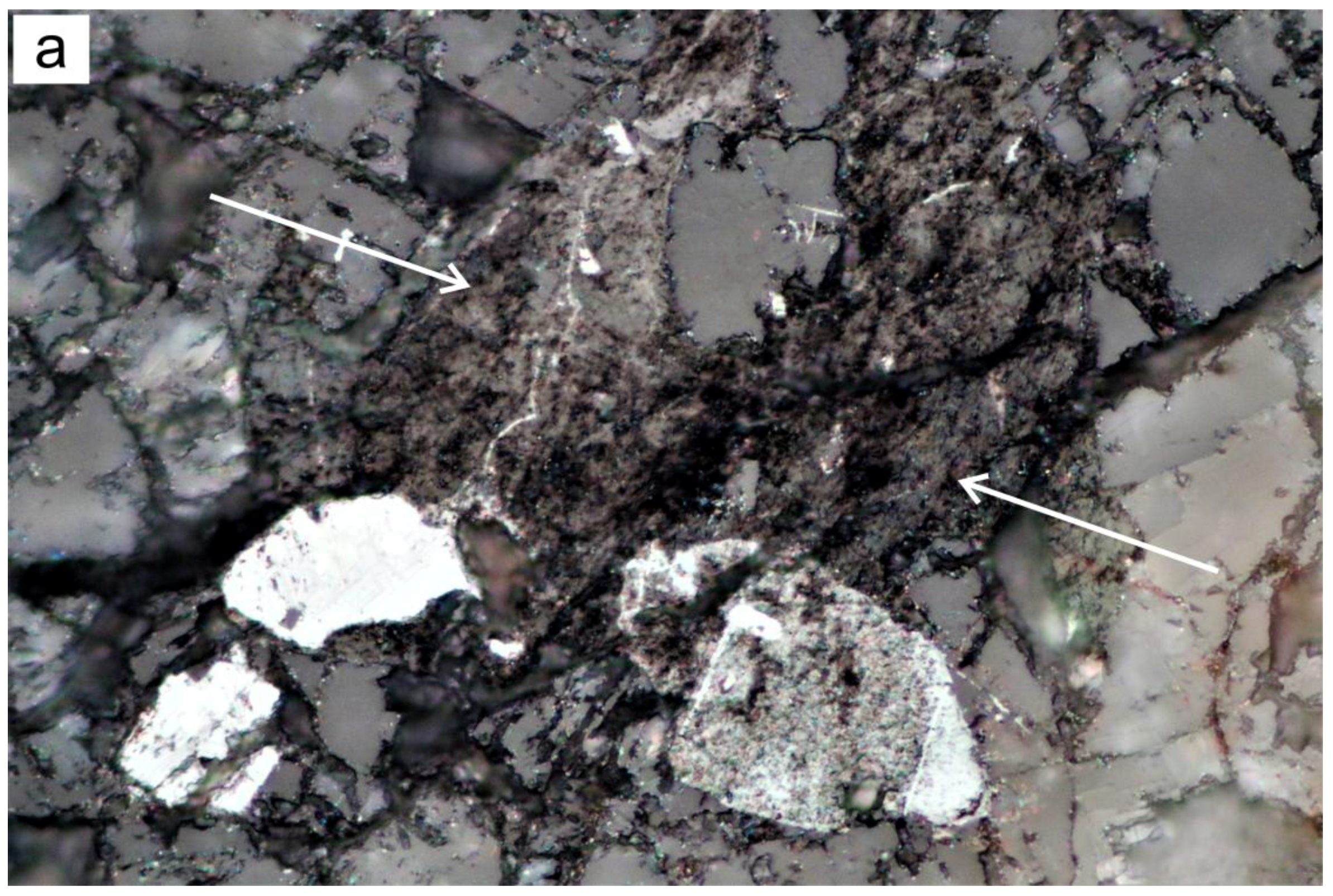
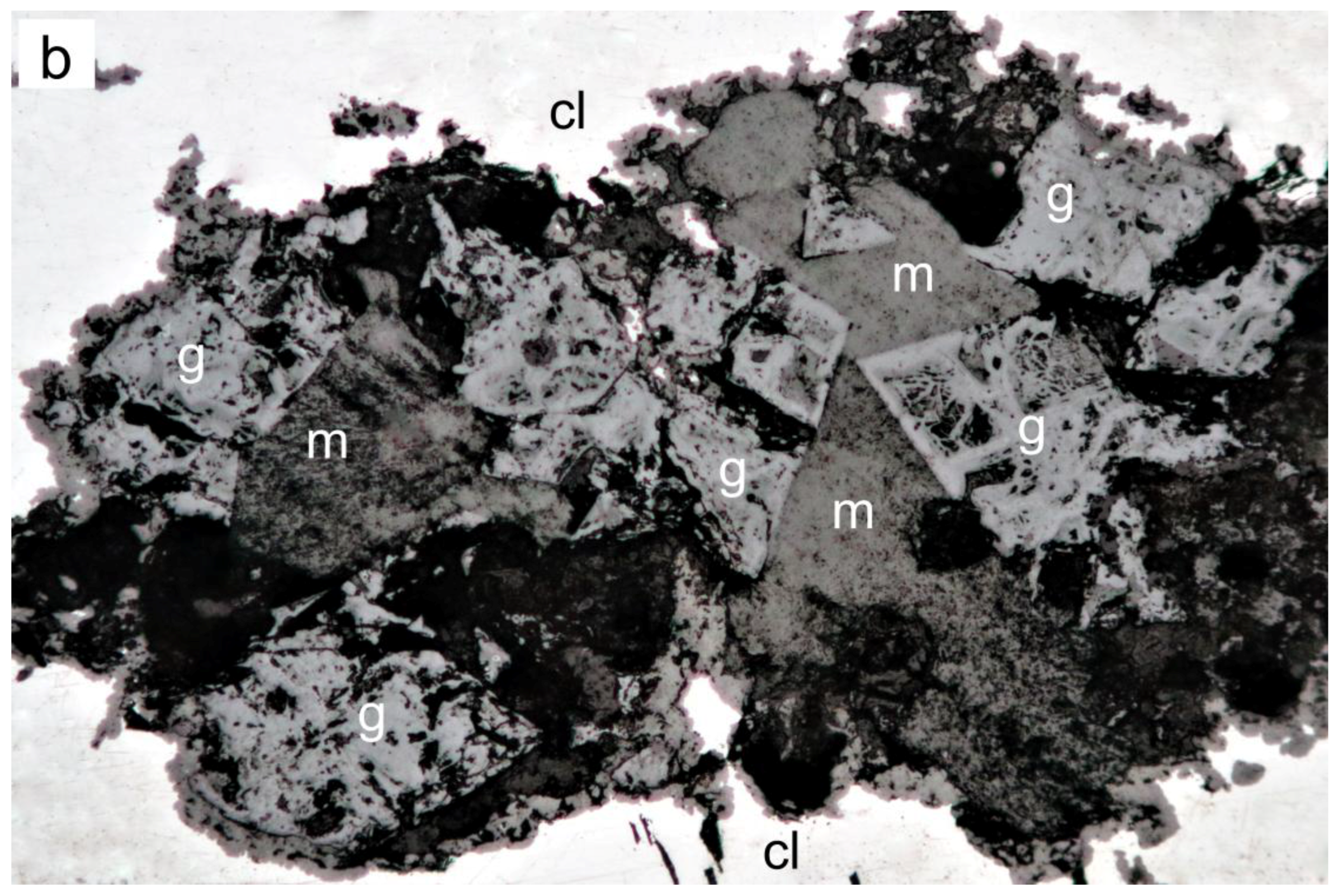
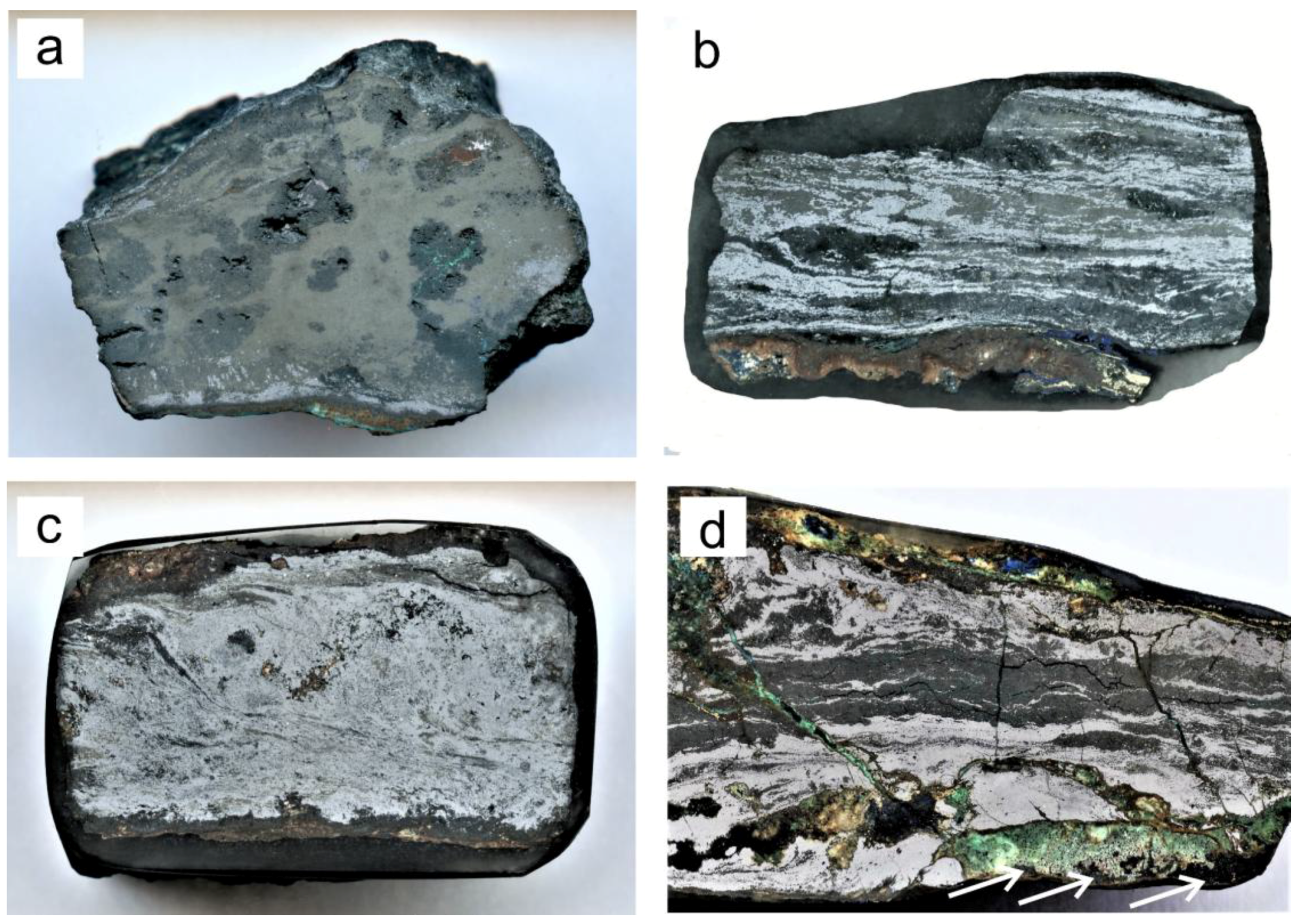
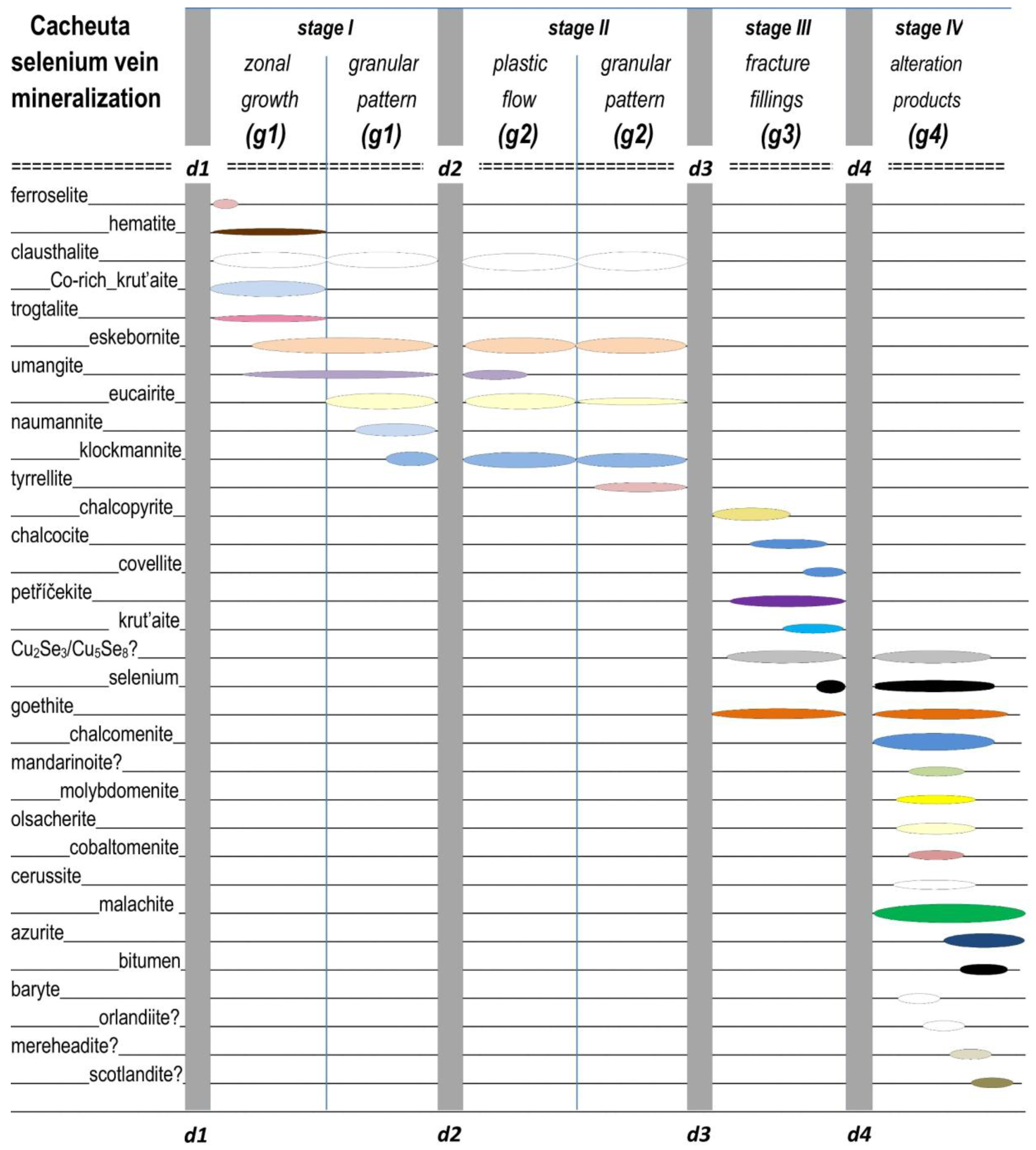
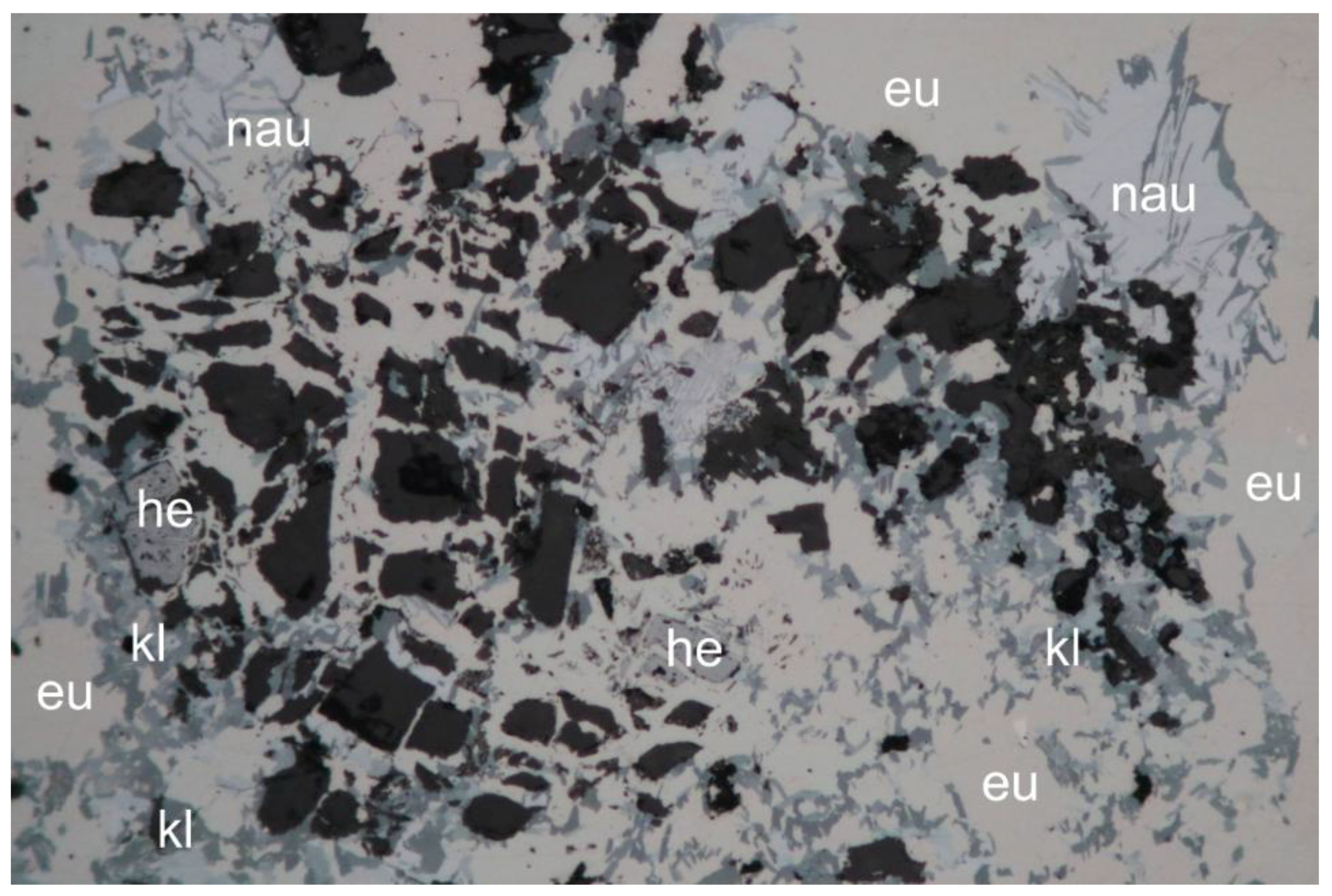
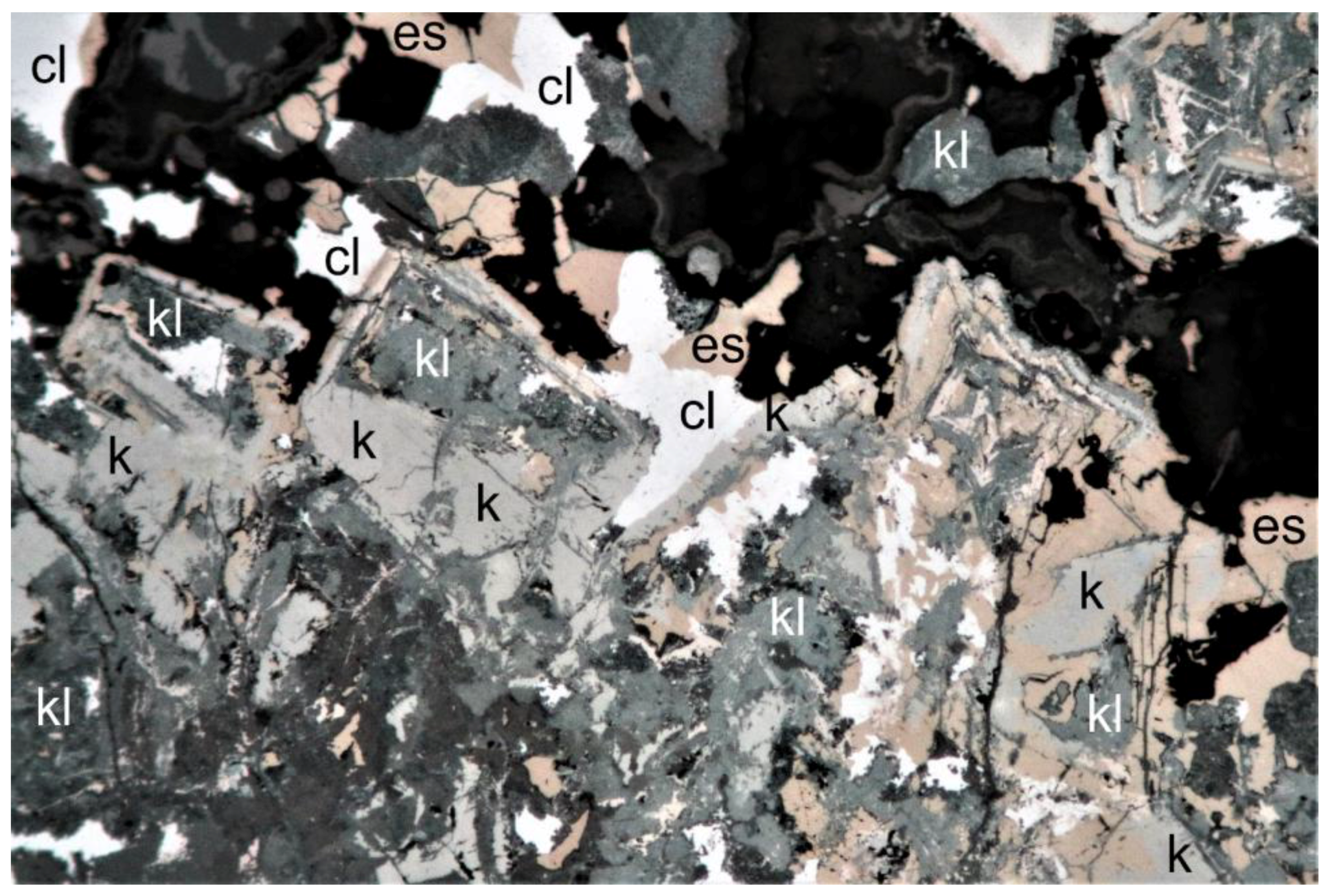
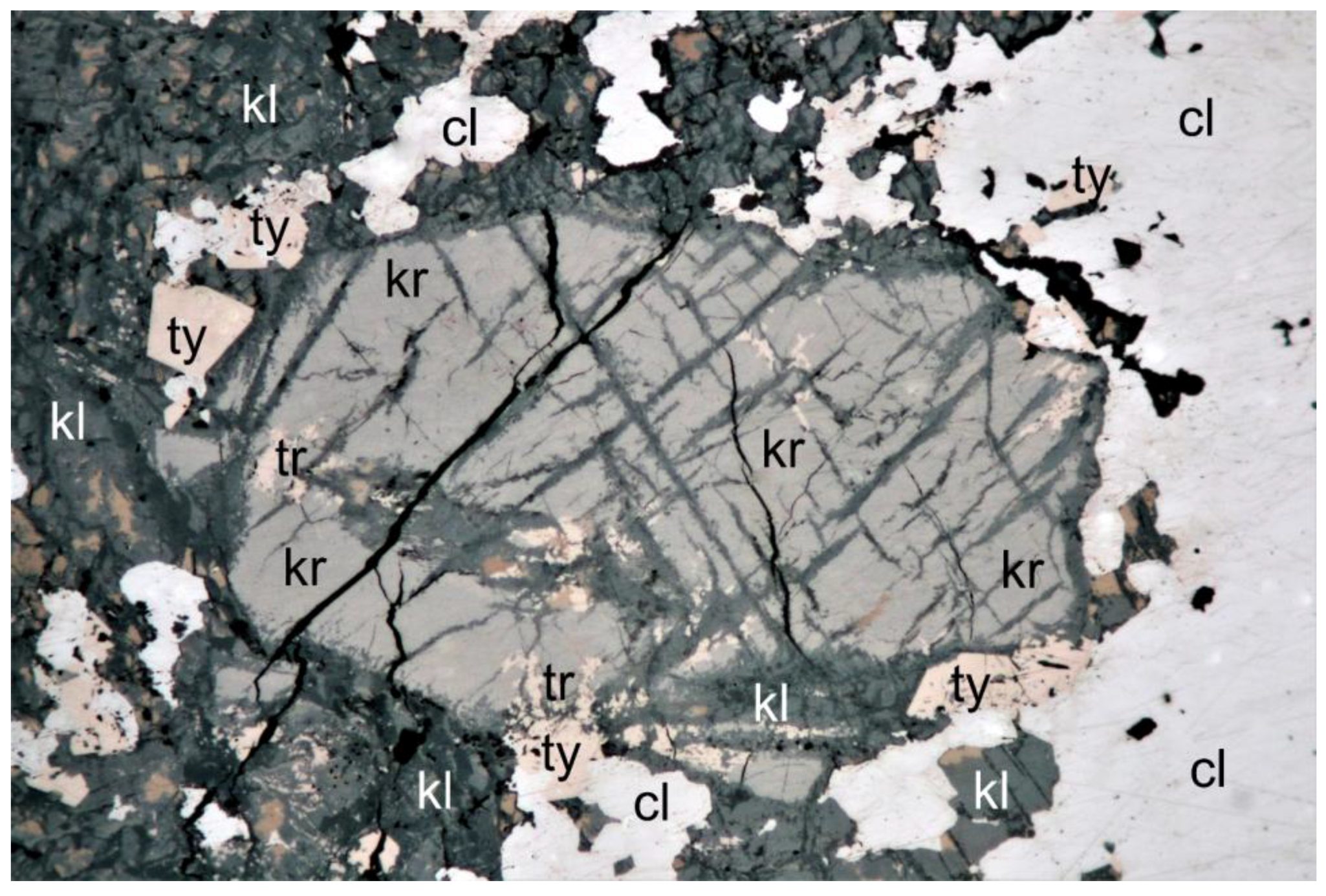
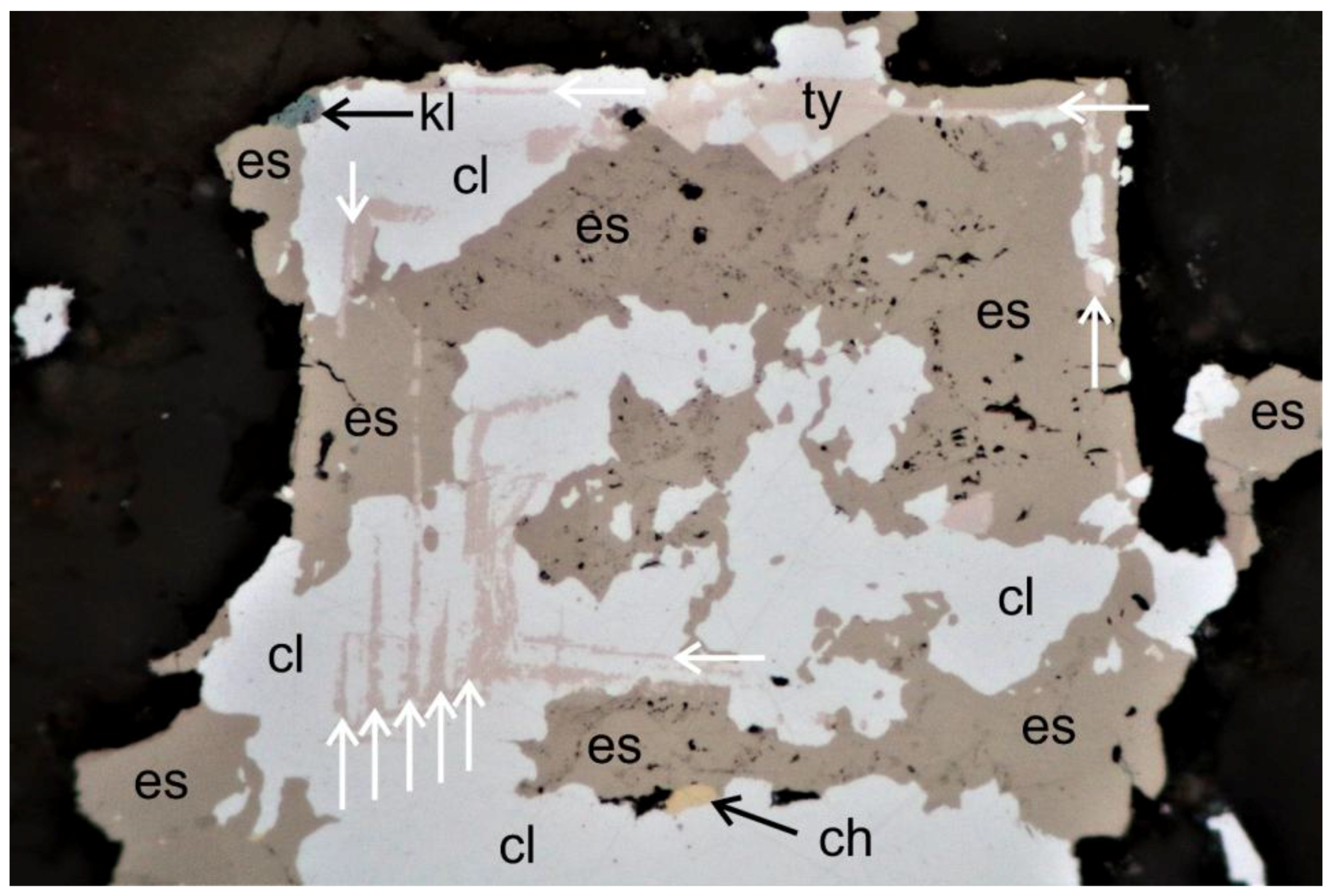
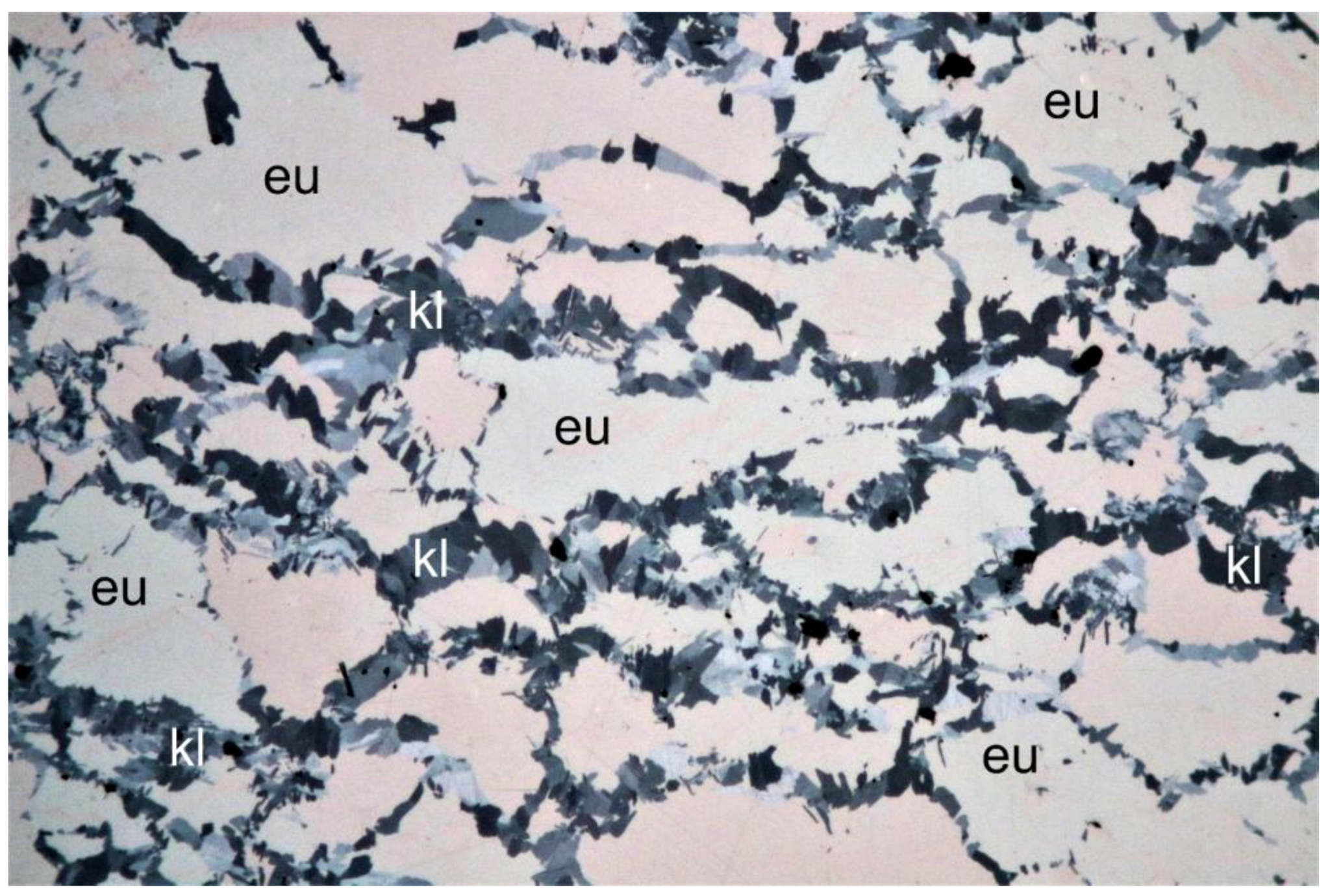


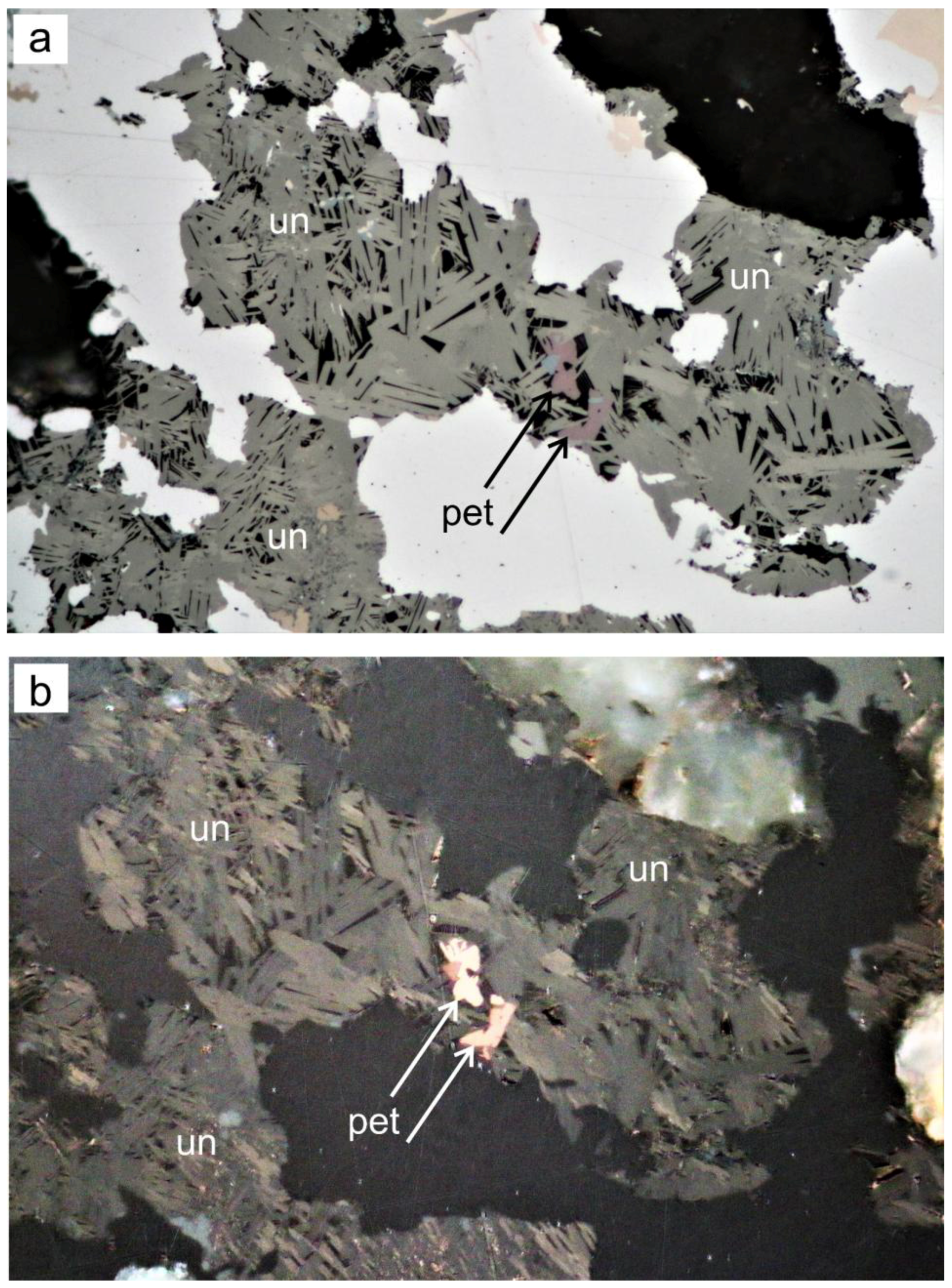
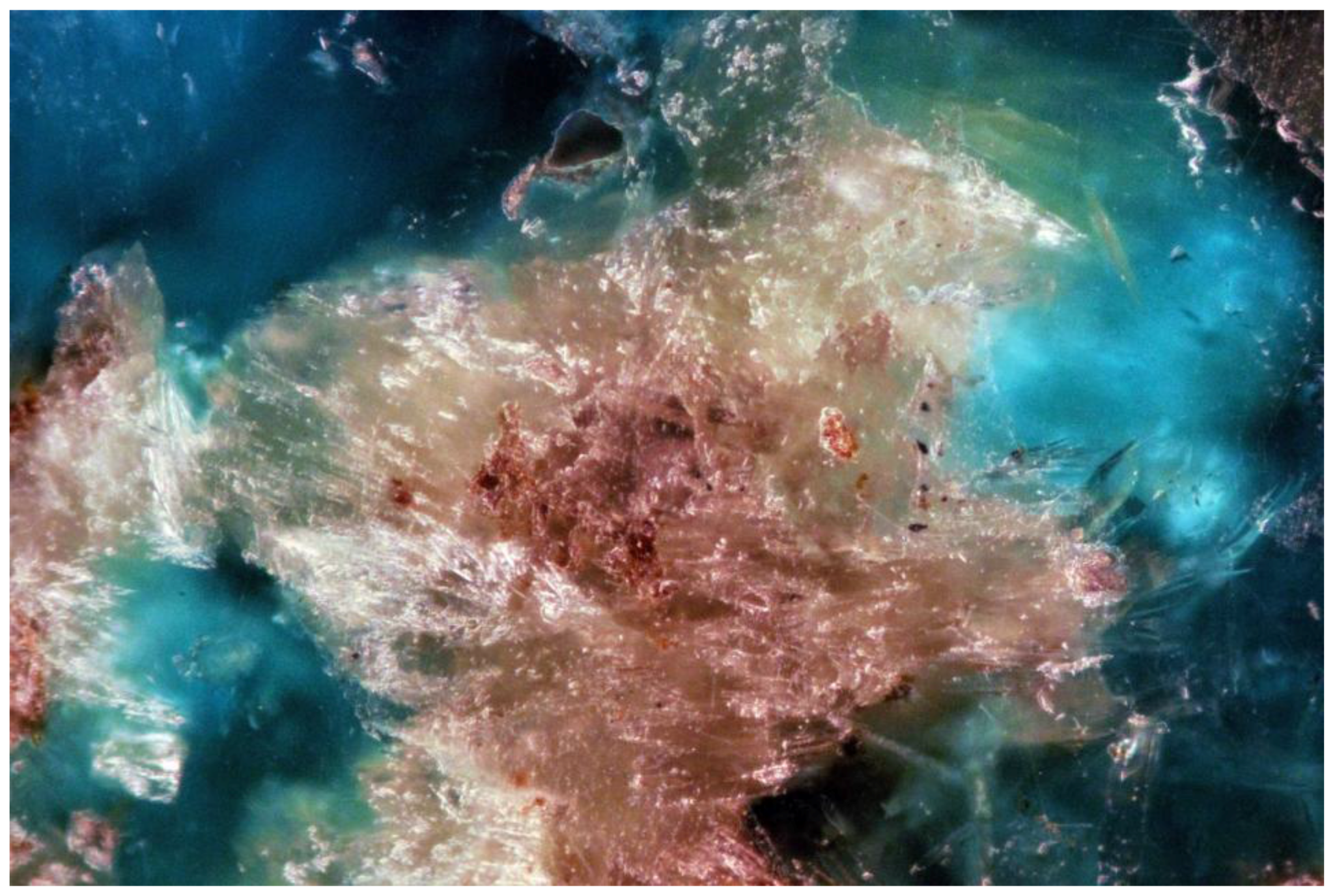
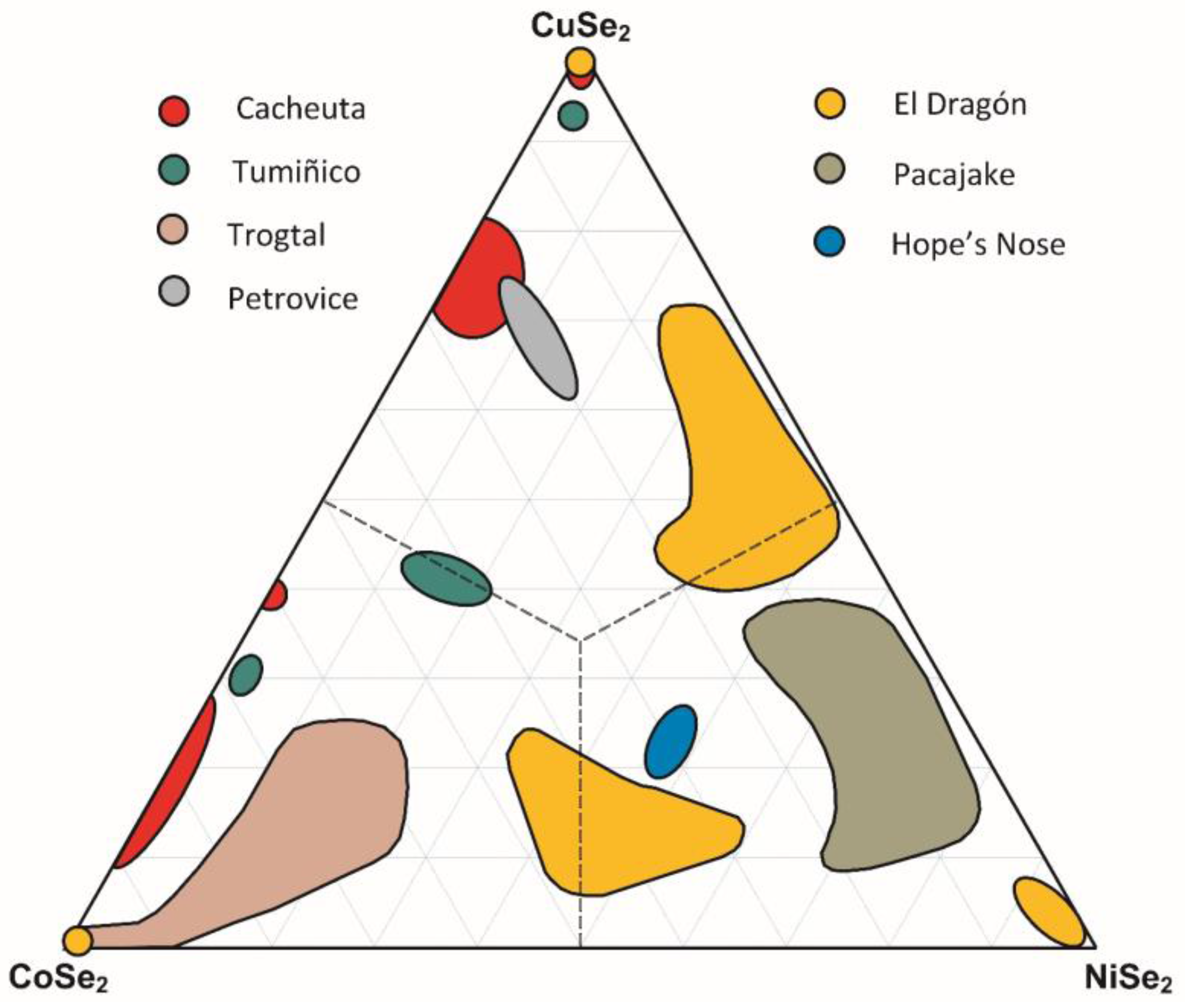
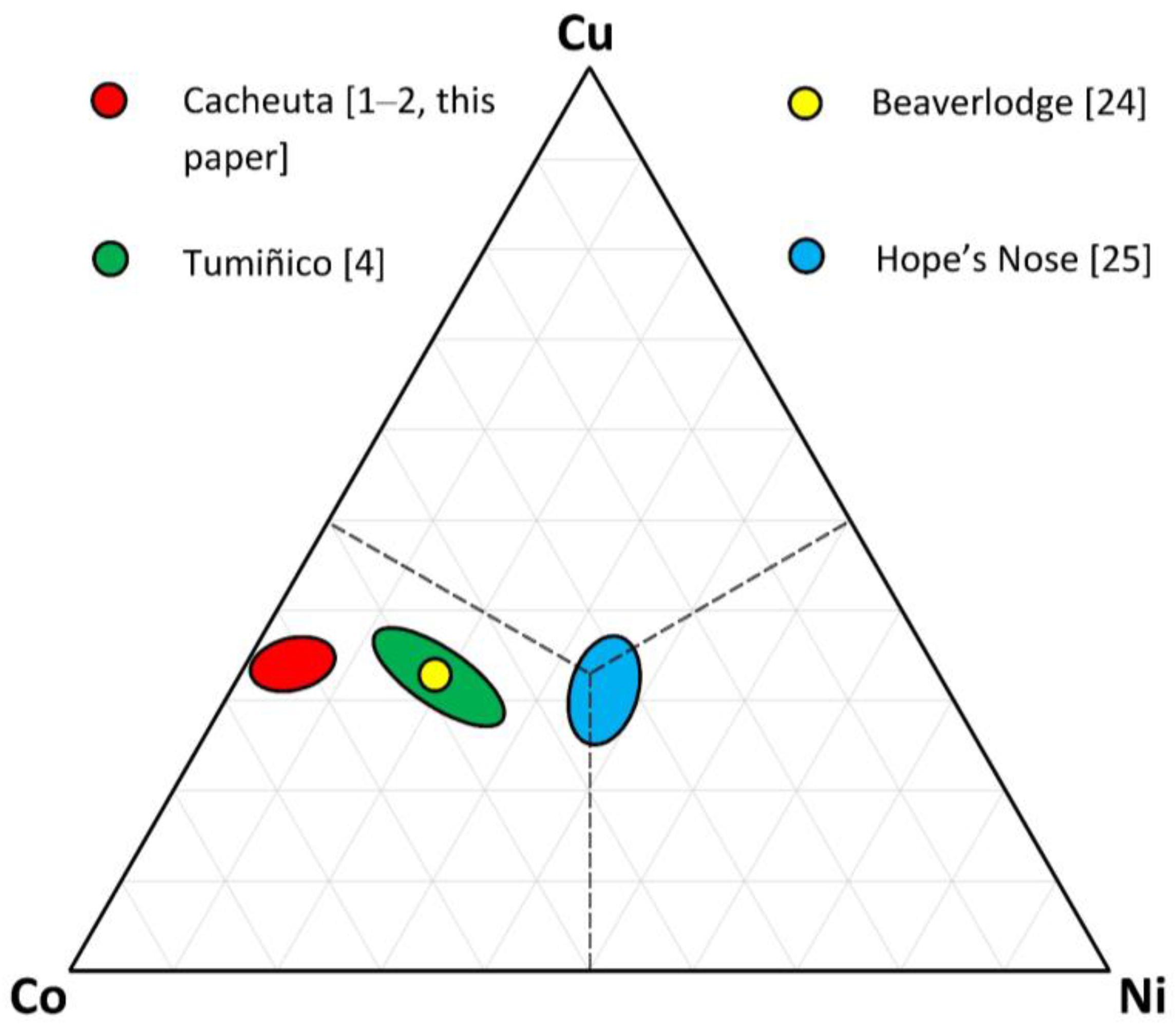
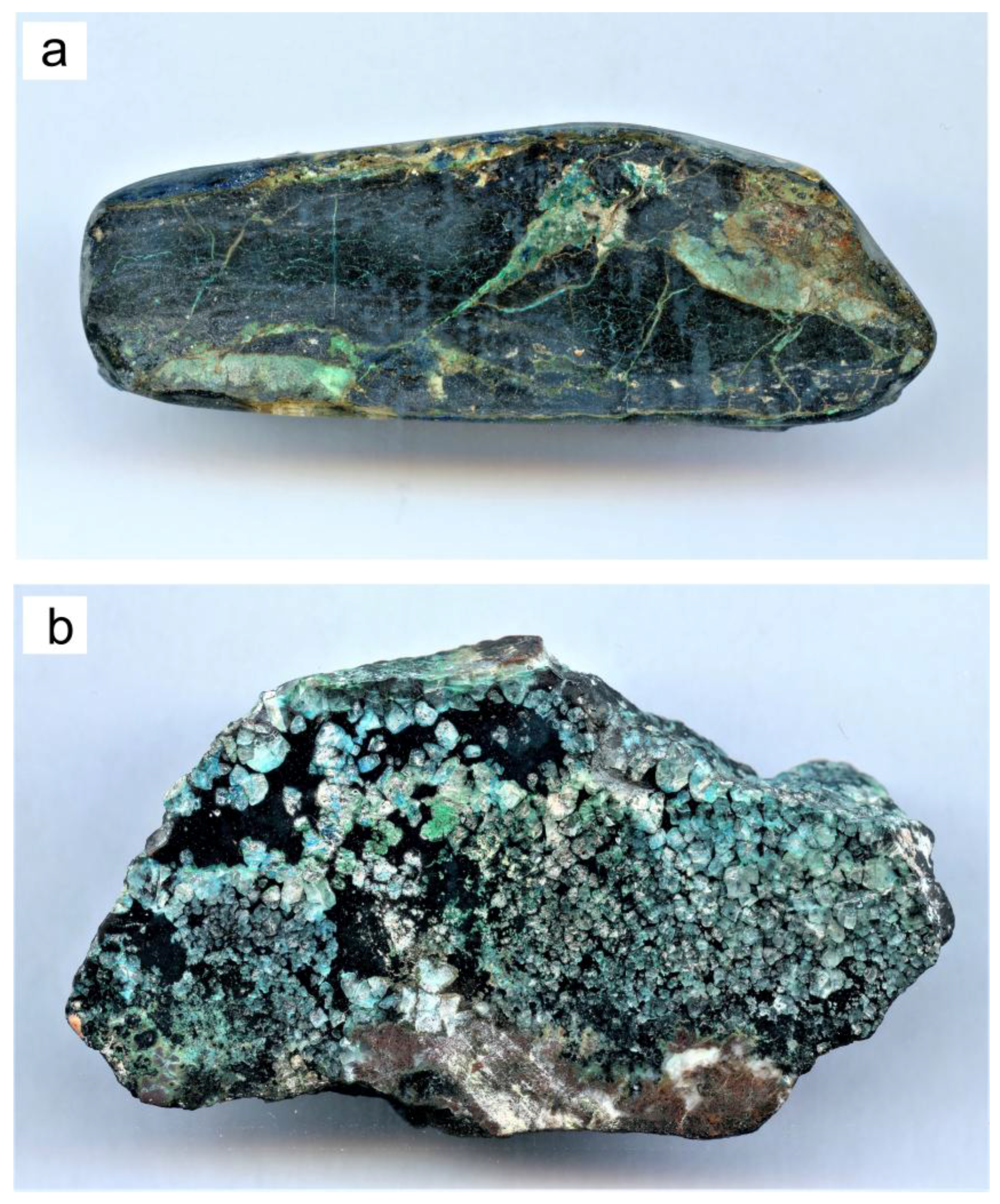
| Mineral | Type 1 | Type 2 | Type 3 | Type 4 | Type 5 |
|---|---|---|---|---|---|
| Eucairite | 70 | 30 | <1 | <1 | 7 |
| Clausthalite | 5 | 40 | 75 | 50 | 25 |
| Klockmannite | 20 | 15 | 5 | 45 | 25 |
| Naumannite | 4 | 13 | 2 | <1 | <1 |
| Umangite | <1 | <1 | <1 | <1 | 40 |
| Eskebornite | 1 | 2 | 15 | 2 | 2 |
| Tyrrellite | <1 | <1 | 2 | <1 | <1 |
| Krut’aite | <1 | <1 | 1 | 2 | 1 |
| Trogtalite | <1 | <1 | <1 | <1 | <1 |
| Petříčekite | <1 | <1 | <1 | <1 | ? |
| Element/# | 1 | 2 | 3 | 4 | 5 | 6 | 7 | 8 | 9 | 10 | 11 |
|---|---|---|---|---|---|---|---|---|---|---|---|
| Cu (wt %) | 18.37 | 20.19 | 20.78 | 28.48 | 42.87 | 44.09 | 22.66 | 22.67 | 28.32 | 27.78 | 28.11 |
| Ag | 3.80 | 1.50 | 0.89 | b.d | 2.24 | 0.73 | 0.19 | 0.16 | b.d | b.d | 0.53 |
| Pb | 0.06 | 0.06 | 0.09 | b.d | b.d | b.d | b.d | b.d | 0.11 | 0.40 | 0.20 |
| Fe | 0.64 | 0.50 | 1.15 | 0.05 | b.d | b.d | 20.33 | 20.45 | b.d | 0.21 | 0.48 |
| Co | 5.99 | 6.69 | 6.11 | 0.11 | b.d | b.d | b.d | b.d | b.d | b.d | b.d |
| Ni | 1.22 | 0.45 | 0.47 | b.d | b.d | b.d | b.d | b.d | b.d | b.d | b.d |
| S | 0.04 | 0.04 | 0.05 | 0.03 | b.d | b.d | b.d | b.d | b.d | 0.06 | 0.06 |
| Se | 70.73 | 70.78 | 70.97 | 71.17 | 55.59 | 55.67 | 56.40 | 56.67 | 71.33 | 71.61 | 70.99 |
| Total | 100.85 | 100.21 | 100.51 | 99.84 | 100.70 | 100.50 | 99.58 | 99.92 | 99.76 | 100.06 | 100.34 |
| Element/# | 1 | 2 | 3 | 4 | 5 | 6 | 7 | 8 | 9 | 10 | 11 |
|---|---|---|---|---|---|---|---|---|---|---|---|
| Cu (wt %) | 25.44 | 25.53 | 0.74 | 1.36 | 1.72 | 12.86 | 12.90 | 12.75 | 4.17 | 7.48 | 6.20 |
| Ag | 43.59 | 43.27 | 72.43 | 71.74 | 0.09 | b.d | b.d | b.d | 0.08 | 0.95 | 0.35 |
| Hg | 0.14 | b.d. | b.d. | 0.28 | b.d. | b.d. | b.d. | b.d. | b.d. | b.d. | b.d. |
| Pb | b.d. | 0.08 | b.d. | b.d. | 70.19 | b.d. | b.d. | 0.08 | b.d. | b.d. | b.d. |
| Fe | b.d. | b.d. | b.d. | b.d. | b.d. | 0.09 | 0.12 | 0.08 | 0.38 | 0.78 | 0.31 |
| Co | b.d. | b.d. | b.d. | b.d. | 0.06 | 22.38 | 22.33 | 20.83 | 21.80 | 19.82 | 21.66 |
| Ni | b.d. | b.d. | b.d. | b.d. | b.d. | 0.74 | 1.19 | 2.72 | 1.23 | b.d. | b.d. |
| S | b.d. | b.d. | b.d. | b.d. | b.d. | 0.31 | 0.22 | 0.09 | 0.17 | 0.10 | 0.09 |
| Se | 31.35 | 31.25 | 27.02 | 27.01 | 28.46 | 63.19 | 63.16 | 63.33 | 72.01 | 71.33 | 71.74 |
| Total | 100.52 | 100.14 | 100.19 | 100.39 | 100.52 | 99.57 | 99.92 | 99.89 | 99.84 | 100.46 | 100.35 |
| (1) La Rioja Province |
|
| (2) Mendoza Province |
|
© 2018 by the authors. Licensee MDPI, Basel, Switzerland. This article is an open access article distributed under the terms and conditions of the Creative Commons Attribution (CC BY) license (http://creativecommons.org/licenses/by/4.0/).
Share and Cite
Grundmann, G.; Förster, H.-J. The Sierra de Cacheuta Vein-Type Se Mineralization, Mendoza Province, Argentina. Minerals 2018, 8, 127. https://doi.org/10.3390/min8040127
Grundmann G, Förster H-J. The Sierra de Cacheuta Vein-Type Se Mineralization, Mendoza Province, Argentina. Minerals. 2018; 8(4):127. https://doi.org/10.3390/min8040127
Chicago/Turabian StyleGrundmann, Günter, and Hans-Jürgen Förster. 2018. "The Sierra de Cacheuta Vein-Type Se Mineralization, Mendoza Province, Argentina" Minerals 8, no. 4: 127. https://doi.org/10.3390/min8040127




